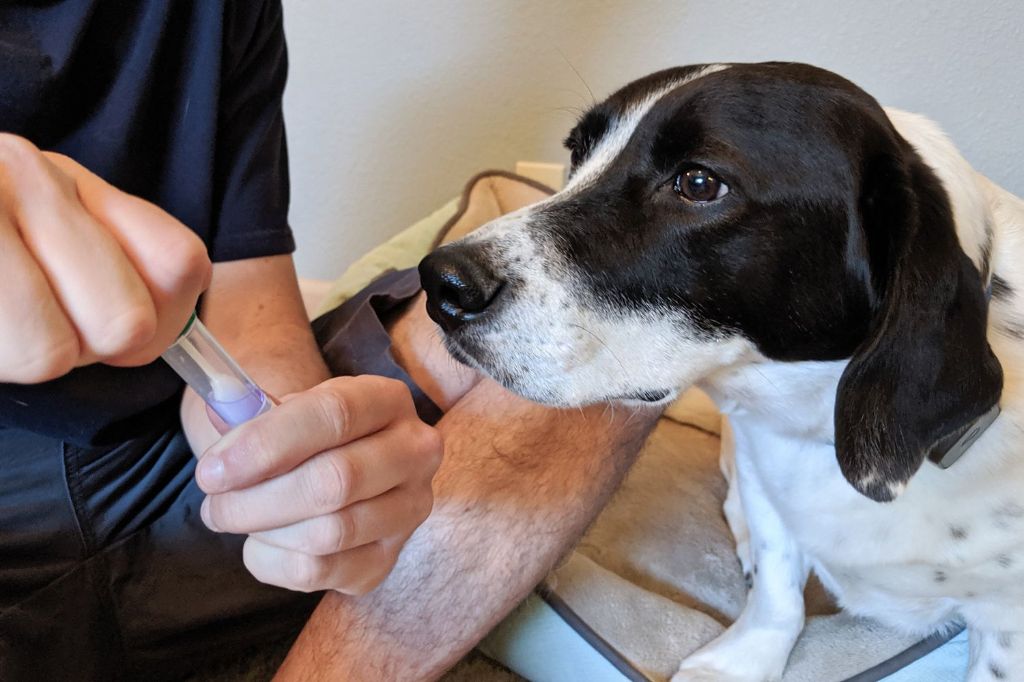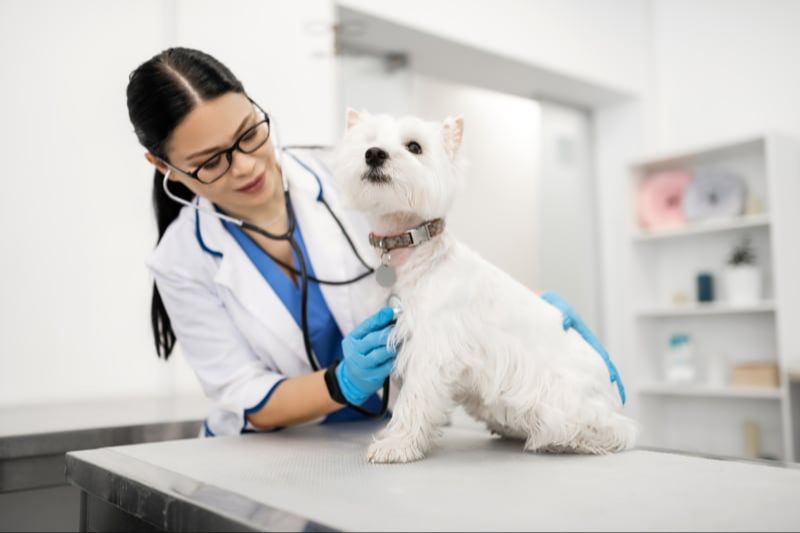Introduction
Embark is a dog DNA testing company that provides detailed genetic information about your dog through a simple cheek swab. Their tests analyze over 350 genetic markers and screen for over 250 genetic health conditions to give you insights into your dog’s breed, ancestry, family tree, health risks and genetic traits.
One piece of information Embark tests provide is your dog’s inbreeding coefficient. This can help you understand if your dog is at risk for health issues associated with inbreeding. In this article, we’ll cover the basics of dog inbreeding, what Embark tests for, and what you can do with the results.
Basics of Dog Inbreeding
Inbreeding is the mating of closely related dogs, such as between siblings or parents and offspring. It occurs due to the limited gene pool within some breeds. Inbreeding can increase the chances that recessive genetic mutations are expressed. When sibling dogs mate, there is a 25% chance of offspring being homozygous or having two identical copies of an abnormal gene.
Inbreeding happens for several reasons. Some breeders intentionally inbreed to maintain purity or fix certain desired traits within their breed line. It also occurs unintentionally in small or isolated breeding populations where there are limited mate options. Popular sires that produce many offspring also increase chances of inbreeding down the line.
Inbreeding raises health risks including birth defects, lowered immunity, reduced fertility, and greater susceptibility to disease. However, the actual risks depend on how closely the dogs are related and the number of generations that inbreeding occurred. Dogs from highly inbred lines are more likely to exhibit health issues.
Does Embark Test for Inbreeding?
Yes, Embark tests do provide some useful information about inbreeding, though they do not test for it directly. One of the key things Embark tests reveal is a dog’s inbreeding coefficient.
The inbreeding coefficient indicates the probability that two alleles (versions of a gene) are identical because they are inherited from a common ancestor. The higher the inbreeding coefficient, the more related the dog’s parents were.
Embark reports the inbreeding coefficient for each dog tested. An average coefficient is around 5%, while highly inbred dogs may have coefficients over 10%. Values over 25% indicate very close inbreeding.

So while Embark does not have a specific “inbreeding test”, the inbreeding coefficient can indicate if a dog comes from an inbred lineage. The lower the coefficient, the less related the parents.
Inbreeding Coefficient
The inbreeding coefficient is a value calculated by DNA testing companies like Embark to indicate the level of inbreeding in a dog. It ranges from 0% to 25%, with higher percentages indicating a greater level of inbreeding.
An inbreeding coefficient of 10% or above is generally considered high and may indicate potential health risks from inbreeding. However, the actual health impact depends on many factors. A high coefficient alone does not guarantee the dog will have issues.
What the coefficient specifically measures is the percentage of genes that are identical copies inherited from a common ancestor. For example, a coefficient of 25% means a dog inherited identical gene copies from a common ancestor for 25% of its genome.
The lower the coefficient, the less related the parents are. A value of 0% would mean the parents are entirely unrelated. Most well-bred dogs from responsible breeders score between 0-5%.
So in summary, the inbreeding coefficient gives a numerical indicator of the degree of inbreeding in a dog’s ancestry. Lower percentages represent lower genetic diversity and higher chances of inherited disorders.
Limitations of Embark’s Inbreeding Detection
While Embark’s breed + health DNA test provides some valuable insights into your dog’s genetic diversity, it’s important to note the test’s limitations when identifying inbreeding.
Embark cannot access your dog’s full pedigree or genetic history beyond the parents. The test only utilizes the portions of DNA that Embark analyzes, which does not represent your dog’s complete genome.
Without a comprehensive pedigree analysis going back multiple generations, Embark can only estimate the inbreeding coefficient and levels of genetic diversity. The test cannot definitively confirm whether your dog is the product of direct inbreeding between closely related ancestors.
For these reasons, Embark’s inbreeding stat should not be taken as proof that your dog is or isn’t inbred. The test provides one data point, but limited information compared to a complete multi-generational pedigree analysis.
Other Health Tests
In addition to testing for inbreeding, Embark screens for over 175 genetic health conditions and traits. Many of these tests can also help identify potential health problems that may be more likely due to inbreeding.
Some of the key tests that can be relevant when assessing inbreeding risks include:
- Diversity Index – Measures genetic diversity across the genome, which can be reduced by inbreeding.
- MHC Class II – Associated with immune system function, which may be compromised by inbreeding.
- Coat Color – Certain rare coat colors are more common in closely related dogs.
- Body Size – Inbreeding can lead to either larger or smaller size than breed standards.
- Skeletal Abnormalities – Increased risks of certain bone/joint issues due to lack of genetic diversity.
While not a direct indicator of inbreeding itself, these associated tests can help provide a fuller picture of your dog’s genetic health and diversity when used alongside the inbreeding coefficient.

Is My Dog Inbred?
Many dog owners worry that their pet may be the product of inbreeding, especially if they discover a high inbreeding coefficient on a DNA test like Embark. However, there are limitations to what these tests can tell you.
Having a high coefficient alone does not necessarily mean your dog will have health problems or is poorly bred. The coefficient is a probability, not a guarantee. Some dogs with low coefficients still inherit genetic diseases while dogs with high coefficients can lead healthy lives.
Likewise, common physical signs thought to indicate inbreeding like overbites, underbites, and crooked tails are not definitive proof. These traits can appear in well-bred dogs too.
The best advice is not to panic if your Embark results show a high coefficient. Monitor your dog’s health, but don’t assume the worst. Get scheduled vet checkups to catch any issues early. Consider doing additional genetic screening tests for breed-specific diseases.
If your dog already struggles with health problems, inbreeding may be a contributing factor. Discuss any concerns with your vet. Increased vet care and lifestyle adjustments can help manage conditions and give your dog the best quality of life.
While high coefficients may raise the risk, they don’t guarantee your dog will have issues. With proper care and love, even dogs with some inbreeding can live happily and healthily.
Reducing Inbreeding Risks
Inbreeding can increase the chances of genetic health problems, so it’s important for breeders and buyers to reduce risks. Here are some tips:
For breeders:
- Research pedigrees and aim for an inbreeding coefficient under 6.25%
- Breed genetically diverse dogs from different lines/regions
- Limit the use of popular sires
- DNA test breeding dogs for breed-specific conditions
- Carefully select the best matches from a litter
- Outcross after a few generations to diversify the gene pool
For buyers:
- Ask the breeder about genetic testing and inbreeding coefficients
- Select a puppy from parents with diverse pedigrees
- Avoid breeders who primarily breed direct relatives
- Consider an adult dog from a rescue/shelter as an alternative
- Research health risks associated with extremely purebred dogs

By carefully selecting breedings and puppies, both breeders and owners can reduce the risks associated with inbreeding.
Other Signs of Inbreeding
While DNA tests are the most accurate way to determine if a dog is inbred, there are some physical and behavioral signs that may indicate inbreeding.
Some physical signs include:
- Facial deformities like an underbite or overbite
- Abnormal body shape or proportion
- Fused toes
- Skin conditions like allergies or thinning fur
- Higher incidence of disease or disability
- Lower fertility rates
Behavioral signs can include:
- Fearfulness or aggression towards people or other dogs
- Separation anxiety
- Repetitive behaviors like tail chasing or licking
- Lower ability to learn or train
However, many of these signs could also be caused by other factors. DNA testing provides the most definitive evidence of inbreeding and can help identify potential health risks.
Conclusion

In summary, Embark tests can provide breeders and dog owners with valuable insights into potential inbreeding through their inbreeding coefficient. This measure gives you a general sense of the genetic diversity in your dog’s pedigree. However, it has limitations and does not confirm whether your individual dog will have health problems. Other than the inbreeding coefficient, Embark also offers a wide range of genetic health screening that can pinpoint inherited diseases your dog may be predisposed to. While a low inbreeding coefficient is reassuring, it does not guarantee your dog will be free of all genetic illnesses. Nevertheless, Embark empowers you to make informed breeding choices to reduce future risks. If you notice any troubling signs in your dog, consult your veterinarian regardless of Embark results.
